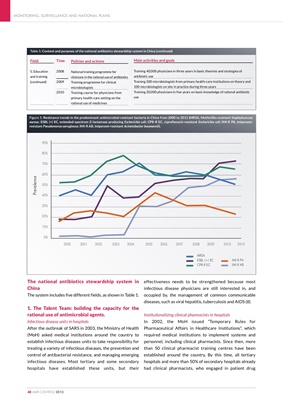
The national antibiotics stewardship system in
China
The system includes five different fields, as shown in Table 1.
1. The Talent Team: building the capacity for the
rational use of antimicrobial agents.
Infectious disease units in hospitals
After the outbreak of SARS in 2003, the Ministry of Health
(MoH) asked medical institutions around the country to
establish infectious diseases units to take responsibility for
treating a variety of infectious diseases, the prevention and
control of antibacterial resistance, and managing emerging
infectious diseases. Most tertiary and some secondary
hospitals have established these units, but their
effectiveness needs to be strengthened because most
infectious disease physicians are still interested in, and
occupied by, the management of common communicable
diseases, such as viral hepatitis, tuberculosis and AIDS (8).
Institutionalizing clinical pharmacists in hospitals
In 2002, the MoH issued "Temporary Rules for
Pharmaceutical Affairs in Healthcare Institutions", which
required medical institutions to implement systems and
personnel, including clinical pharmacists. Since then, more
than 50 clinical pharmacist training centres have been
established around the country. By this time, all tertiary
hospitals and more than 50% of secondary hospitals already
had clinical pharmacists, who engaged in patient drug
MONITORING, SURVEILLANCE AND NATIONAL PLANS
48 AMR CONTROL 2015
2000 2001 2002 2003 2004 2005 2006 2007 2008 2009 2010 2010
Prevalence
90%
80%
70%
60%
50%
40%
30%
20%
10%
0%
IMI-R PA
IMI-R AB
MRSA
ESBL (+) EC
CPR-R EC
Figure 1: Resistance trends in the predominant antimicrobial-resistant bacteria in China from 2000 to 2011 (MRSA, Methicillin-resistant Staphylococcus
aureus; ESBL (+) EC, extended-spectrum β-lactamase producing Escherichia coli; CPR-R EC, ciprofloxacin-resistant Escherichia coli; IMI-R PA, imipenemresistant
Pseudomonas aeruginosa; IMI-R AB, imipenem-resistant Acinetobacter baumannii).
Table 1: Content and purposes of the national antibiotics stewardship system in China (continued)
Field
5. Education
and training
(continued)
Time
2008
2009
2010
Policies and actions
National training programme for
clinicians in the rational use of antibiotics
Training programme for clinical
microbiologists
Training course for physicians from
primary health-care setting on the
rational use of medicines
Main activities and goals
Training 40,000 physicians in three years in basic theories and strategies of
antibiotic use
Training 500 microbiologists from primary health-care institutions on theory and
100 microbiologists on site in practice during three years
Training 20,000 physicians in five years on basic knowledge of rational antibiotic
use